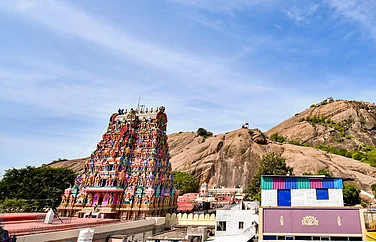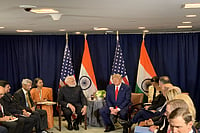Since the Bharatiya Janata Party (BJP) came to power in 2014, one of its key mantras has been "minimum government, maximum governance,” which means reducing the size of government and operations.
The main objective of Prime Minister Narendra Modi's decades-long rule has been to privatise several public utilities in various sectors, including aviation, telecommunications and energy. Disinvestment and strategic sales were key parts of these efforts.
Ahead of the Union Budget 2021, Prime Minister Modi said in an interview: “Modernise and monetise'', saying that many of the PSUs (Public Sector Units) are in the red and privatisation will help revitalise these sectors. He clarified that the government is focused on privatising all PSUs except four strategic sectors.
The first large-scale privatisation began with the sale of the national airline. The government said that the move is aimed at improving financial soundness and operational efficiency. Further, changes have also taken place in the banking sector aimed at increasing efficiency and reducing government intervention. As part of this strategy, some public banks were privatised or consolidated.
Private sector participation in infrastructure projects such as highways, airports and railways has also been encouraged through various models such as public-private partnerships (PPPs) to attract investment and promote development.
Public Private Partnership (PPP)
The PPP model in India was not introduced by any particular political party like the Indian National Congress. Rather, the introduction of the PPP model was the result of political initiatives and economic reforms spanning multiple governments of different political parties.
But PPP’s formal recognition in India gained momentum during the era of economic liberalisation and reforms that began in the early 1990s.
Over the decades, governments, irrespective of their ruling party, started to claim the need for private sector participation to address infrastructure development, service delivery, and resource mobilisation challenges. In 1991, the Congress government faced a difficult political climate under the leadership of Rajiv Gandhi.
The country was suffering from economic difficulties and reforms were needed. After Rajiv Gandhi was assassinated during the election campaign, the Congress party led by Prime Minister P. V. Narasimha Rao formed the government.
In response to the severe balance of payments crisis, the government introduced a series of economic liberalisation policies often referred to as the “New Economic Policy'' or “LPG reform'' (liberalisation, privatisation, and globalisation). These reforms were aimed at opening up India's economy, encouraging foreign investment, privatising state-owned enterprises, and reducing bureaucratic controls.
The BJP-led government of India continues, and in some cases accelerates, the reform process of the 1990s with the aim of promoting economic growth, attracting investment, and improving efficiency in various sectors. Key points associated with the BJP's privatisation drive were strategic disinvestment, liberalisation of foreign direct investment, monetisation of assets, and introduction of reforms in agricultural and labour laws.
It is important to note that the scope and impact of these measures may be subject to debate, and opinions about the successes and challenges of privatisation efforts may differ. The scope and pace of privatisation varied by sector, and there was debate about the impact of these measures on economic growth, efficiency, and social justice.
While some argue that privatisation has contributed to economic growth and efficiency in certain sectors, others have expressed concerns about job losses, social inequality, and the potential for concentration of wealth.
The debate around privatisation also highlights the ills of it: social inequalities, resulting in marginalised communities being most affected by economic growth and certain groups benefitting disproportionately.
As technology develops and the need for manual labour declines, privatisation has also led to job losses, particularly in sectors where there is over employment in state-owned enterprises. This has deepened social and political problems. In some cases, privatisation has raised concerns about the affordability of essential services such as health care and education, as private providers may prioritise profitability. And critics primarily argue that the privatisation process is prone to corruption and cronyism, allowing well-connected individuals and companies to benefit unfairly.
Politics related to this
Prime Minister Modi's emphasis on privatisation policy has been heavily criticised by opposition parties as “selling the family's silver”.
Successive finance ministers have talked about disinvestment, whether it was the UPA regime or his NDA regime. Experts claim that the term "disinvestment" was used intentionally to avoid a backlash against the sale of state-owned shares in public companies. They have been careful to ensure that their actions do not pose an overt challenge from voters that could upend the election's calculations.
Privatisation and elections are closely related, with the former being pushed into states by large victories of the BJP. However, protest from the opposition have been rampant. Recent farmer protests in India have included opposition to certain agricultural reforms that involve private sector participation. Farmers' organisations have expressed concerns about the potential exploitation by private entities.
Trade unions affiliated with various political parties, including left-leaning ones, have been at the forefront of protests against privatisation. They often organise strikes and demonstrations to oppose what they see as detrimental to workers' interests. Left-leaning parties traditionally advocate for a socialist economic model and are often critical of privatisation. They argue that the privatisation of key industries may lead to increased social inequality and favour big corporations over the welfare of the working class.
Privatisation often manifests itself in welfare systems, development plans, labour laws, and ultimately becomes a factor in elections. With the 2024 general and Lok Sabha state elections looming, government officials, political analysts and economists have said the Center wants to proceed with cautious economic reforms.


























